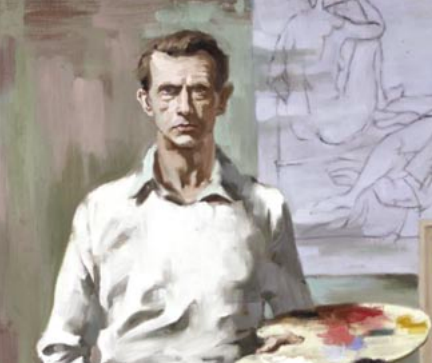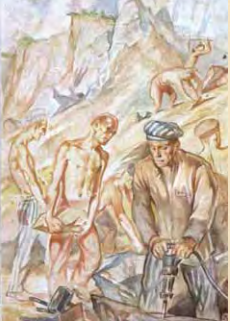Just back on Twitter to share a thread about art, religion, pop culture, WWII, and #StayingAtHome for Easter...
This is one of the most reproduced pieces of religious art in history. Yes, it’s Leonardo da Vinci’s Last Supper. But take a closer look: it’s actually a paint-by-number Last Supper-–the most popular paint-by-number picture of all time.
At the height of the paint-by-number craze fifty years ago, the Last Supper kit was considered its masterpiece. For some it brought a religious dimension to a crafty hobby, for others it was pure kitsch. But it tells a deeper story.
When the Detroit-based Palmer Paint Company launched its line of numbered painting kits in the 1950s, it hired skilled artists to deconstruct images into basic shapes and color schemes. They began with simple subjects, but soon got more ambitious.
Among the most ambitious of the paint-by-number artists was Adam Grant, who designed the Last Supper kit in 1964. Here he is in a self-portrait.
Adam Grant was an immigrant from Poland, where his name had been Adam Grochowski. He was just a teenager when WWII broke out, but he already knew he wanted to be an artist – a dream that somehow endured when he was sent to a Nazi concentration camp.
In Auschwitz, the young artist traded sketches to guards for cigarettes, which he then traded for food. He believed art kept him alive, even when he was transferred to work in the infamous quarries of the Mauthausen camp. This drawing was discovered in his bunk after liberation.
After the war, Grant spent years in a DP camp before the 1948 Displaced Persons Act allowed him into the US. Sponsors in the Polish enclave of Hamtramck, MI found him a home & work designing floats for Detroit’s Christmas parade.
In 1951, Grant’s talent led him to Palmer Paint. The Last Supper kit he designed a decade later helped make paint-by-number more than just a fad with sales in the millions, but a cultural touchstone.
Adam Grant’s Last Supper artist’s proof recently joined the collections of the @Smithsonian. It represents a meeting of religion and commerce at a time when traditional religious observance was in decline, yet portrayals of religious figures remained extremely popular.
As a work of adaptation and a testament to immigrant contributions to American culture, the paint-by-number Last Supper is surprisingly moving. It’s a mass-produced reflection of one man’s survival, filtered through the efforts of millions he inspired to make art of their own.
What does all this have to do with #StayingAtHome? Maybe an elaborate paint-by-number like the Last Supper is a useful way to think about what we& #39;re dealing with now--and not just because we all long for a day when we can again gather around a table like Jesus and his friends.
With no quick end to the task before us, it& #39;s easy to lose sight of the fact that our ultimate goal, huge though it is, can only be achieved through countless small moments of attention. Every day of social distancing is a single careful brush stroke.
Many feel bereft not being able to attend seders this Passover or church this Easter. It helps to remember we are at home alone together, all painting by the numbers we use to organize our days. Yes, it takes patience, but that is itself a kind of faith. /END

 Read on Twitter
Read on Twitter





